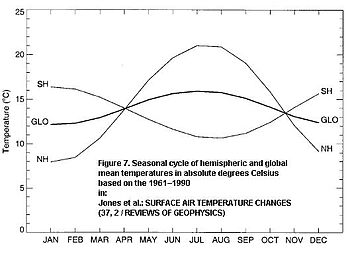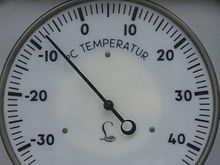Air temperature
The air temperature is the temperature of the atmosphere close to the ground that is neither influenced by solar radiation nor by ground heat or heat conduction .
The exact definition by scientists and technicians differs slightly depending on the subject. In meteorology , the air temperature is measured at a height of two meters, which is what the classic, white-painted weather huts ( thermometer huts ) in the open are used for.
In heating technology and building automation, the outside temperature is measured ; it is determined at a representative location close to the wall, without including the wall radiation and direct solar radiation.
Influences
The main influencing factors on the air temperature are on the one hand the radiation budget of the earth or its local radiation balance and on the other hand mixing effects caused by the wind .
variability
The air temperature varies during the day, the seasons and climatic fluctuations. The highest temperatures ( heat pole ) of almost 60 ° C are observed in the interior of deserts, the lowest values ( cold pole ) occur in the Antarctic (almost −90 ° C).
Annual cycle
In the course of the year, based on either daily or monthly means as long-term averages, the following course can be seen for Central Europe. January is the coldest month, from March to May there is a rapid increase with a maximum in July and from September to December an equally rapid decrease in temperatures.
Daily course
The daily course of the air temperature is directly linked to the daily course of the global radiation and therefore shows a pronounced drop at night, i.e. after sunset . The minimum is reached in the early morning or around sunrise . This tendency is dampened by heavy cloud cover and also wind , especially in the vicinity of larger water surfaces. If the air temperature falls below the dew point , phenomena such as fog , dew or frost can occur. After the temperature has passed its daily minimum, it initially rises quickly and then a little more slowly in the midday hours. It reaches its maximum after the highest point of the sun, in winter usually between 1 p.m. and 2 p.m., in summer between 4 p.m. and 5 p.m., sometimes not until 6 p.m. It then drops rapidly in the evening hours and a little more slowly at night until it again reaches its minimum in the early morning. This normal case of the daily cycle applies to both summer and winter . Dynamic influences such as the ingress of warm or cold air can lead to sometimes considerable deviations and, under certain circumstances, a reversal of the temperature curve. Close to the coast, the sea wind is responsible for the fact that the maximum daily temperature is often reached much earlier at 12 p.m. to 1 p.m., i.e. the temperature no longer increases as the day progresses.
Depending on the height
The change in air temperature with altitude is the most common criterion for dividing the earth's atmosphere into different layers. The troposphere, as the lowest layer, extends over Central Europe for about 11 kilometers. It shows an approximately linear temperature drop from an average of 10 ° C on the ground to 0 ° C in two kilometers, around −20 ° C in five kilometers and finally −55 ° C in ten kilometers. There are two dynamic model cases for this atmospheric temperature gradient , the wet adiabatic and the dry adiabatic . On average, the static temperature decrease is around 0.65 ° C per hundred meters, which is known as the geometric temperature gradient. If there is no further decrease in temperature, the tropopause has been reached. If this is particularly high, as in the tropics, minimum temperatures of −80 ° C can also develop in the troposphere.
In the further course the temperature rises again after a stationary phase, normally from about 25 km altitude. The reason for this is the relatively high ozone concentration and the associated absorption of radiation in this layer of the atmosphere, which is known as the stratosphere . The temperature maximum is reached at around 0 ° C at the level of the stratopause . In the adjoining mesosphere , the temperature drops again and reaches a new minimum of −100 ° C at the mesopause . This is followed by the thermosphere and finally the exosphere with a temperature that increases again, although at these altitudes one can hardly speak of air and they actually already belong to space . The particle density here is so low that even a temperature of several thousand degrees Celsius would not cause any significant heat transport processes.
Measurement methods and instruments
The air temperature is usually measured using a thermometer or measuring probe . As expansion thermometers, the former are usually filled with alcohol or mercury , while the sensors mainly work with semiconductor or thermal effects . Bimetal strips are also used for less accurate measurements .
As a rule, the temperature measurement corresponds to an immersion measurement , which in technology is often accelerated by ventilation . Therefore, the centrifugal thermometer is used for quick but accurate scientific measurements . When reading , however - as with other scales - you have to be careful to look at the scale at right angles, otherwise a parallax error of 1 ° and more can occur. The aspiration psychrometer ( Assmann psychrometer ) is also ventilated (in the air flow of a small impeller), which also gives the wet temperature very precisely.
Many measurement errors are caused by attaching the thermometer in an inconvenient location. An outdoor thermometer should always be installed in the north of the building, but it could also be in the sun for 2 × 1 hour in summer . In addition to the inherent heat of the building (which a few centimeters away from the window glass can help against), the reflection from a neighboring building can falsify the measurement by 1–2 °.
The adjustment of a thermometer to the air temperature takes a certain amount of time, which can take from a few minutes to half an hour. If, for example , you need a quick result with a relatively sluggish room thermometer , you can accelerate the reading by swinging the thermometer with an outstretched hand. The half-life is about 20 seconds, which means after this time the “artificial wind ” has approximated the display on the scale by 50% to the true value.
The air temperature can be estimated to an accuracy of 1–3 ° with no wind and appropriate experience . The perceived temperature in the wind is estimated to be considerably colder due to the wind chill .
The potential temperature is used to compare temperature values measured at different locations and altitudes . If the focus is on the humidity or air density , the virtual temperature is used .
Influences on the measurement accuracy
A measurement to one decimal place, i.e. 0.1 degrees Celsius , is the utmost measurement accuracy that is still possible or useful outdoors, because even slight air movements have an influence of a few tenths of a degree. In addition, even when there is no wind, there are horizontal temperature gradients of the order of 0.1 ° C per meter, which can vary greatly with the position of the sun , rocks and vegetation and can be several degrees near the ground. The so-called temperature field is most stable with a heavily cloudy to overcast sky and moderate wind. When the weather is good , however, it is most restless (see also cloudless and updraft ).
Because of these circumstances, a reliable measurement of the air temperature to an accuracy of about 0.5 ° C already requires considerable precautions, in particular a well-ventilated cover for solar radiation and heat radiation from the ground and buildings. The best location for a temperature sensor or a thermometer is therefore a shady place in the north of a free-standing building.
For laypeople , a measurement accuracy of around 1 ° C can be achieved if the above conditions are met and the measuring device is approximately calibrated . Otherwise errors of up to 3 ° C can occur, and in the case of inadequate radiation protection even above 5 ° C.
The weather stations of the meteorologists measure the temperature at different altitudes, on the one hand to obtain information about the radiation or energy balance , on the other hand to be able to partially take into account the effects mentioned above. The air temperature is the temperature that is measured at a height of exactly 2 m in a weather hut protected from radiation. In addition, the ground temperature is measured: The measurement depths of 5, 10, 20, 50 and 100 cm in the ground are usual.
In astronomy and geodesy , the inevitable anomalies of the near-surface temperature field are among the most unpleasant, because they are difficult to model. The astronomical refraction , on the other hand - as the average, regular refraction of rays - can be calculated relatively well from 3-4 air parameters.
Astronomers call the turbulence which the direction of "distracting" of starlight to 0.5 to 5 Seeing "(air turbulence) or scintillation (" flicker "of the stars), the local climate in the dome of an observatory, a so-called. Saalrefraktion cause .
the surveyors fear these influences less because they are considered random errors in longer series of measurements fall out. contrast Unpleasant is a systematic error by the Seitenrefraktion , particularly in tunnels and sightings occur, (just past a thermally different area as a sunny house wall ). also changing wind systems in the mountains or in technical large-scale projects, critical systematic have influences.
history
In Florence on December 15, 1654, the regular measurement and recording of the daily temperature began.
Standard outside temperature of the heating and cooling technology
For the purposes of the heating power calculation, the heating requirement or the required cooling power is measured on the basis of fixed temperatures. The following applies here:
- According to the German VDI guideline 2067 / DIN 4108 T6, the heating limit is assumed to be 15 ° C; the outside temperature is based on the values determined by the German Weather Service ; the standard outside temperatures are collected in a table and an isothermal map in the national annex to DIN EN 12831 .
- In Austria, Switzerland and Liechtenstein a heating limit of 12 ° C is used, here the temperature values from ZAMG (Austria) and MeteoSwiss (Switzerland and Liechtenstein) are reference values.
See also
Web links
- Climate data from Austria 1971–2000 , ZAMG (selected stations: heating days, heating degree days (number of degree days) and other climate data)
- Climate data for locations in Austria , energiesparhaus.at (heating days, heating degree days, standard outside temperature , solar radiation - extensive, values differ from the official data from ZAMG)
- Standard outside temperatures with isothermal map for Germany
- Anne Preger: December 15, 1654 - Start of measuring and recording the air temperature WDR ZeitZeichen from December 15, 2019 (podcast)
Individual evidence
- ↑ Global Weather & Climate Extremes. World Meteorological Organization , accessed August 10, 2013 .
- ↑ a b P. D. Jones et al .: Surface Air Temperature And Its Changes Over The Past 150 Years, Figure 7 ( Memento from July 16, 2010 in the Internet Archive ) (Page 24 of 28 of the PDF file; 7.8 MB)
- ↑ Ruhr-Universität Bochum: Influence of the seasons on the daily course of temperature ( Memento from March 13, 2006 in the Internet Archive )
- ↑ Standard outside temperatures




